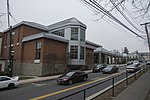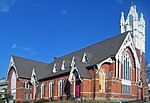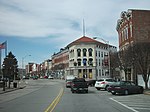Washington School (Ossining, New York)

The former Washington School is located on Croton Avenue (New York State Route 133) in the village of Ossining, New York, United States. It was built in 1907 in the Beaux-Arts style, one of two in the village to use it. It was added to the National Register of Historic Places in 1987.It was built as a high school, in response to the village's rapid growth following industrialization in the early 20th century, from a design by Wilson Potter of New York City, an architect who specialized in schools. It includes what were at the time some of the most progressive and advanced features of school buildings. Its early (for a school) use of the Beaux-Arts style and placement on a rise in the land give it a monumental quality despite its relatively small size. It is no longer used as a school, and has been turned over to the village for reuse. For a time it housed a museum established by the local historical society. In 1973 it was closed by the school district as part of desegregation efforts. Since a 2009 renovation it has been home to the House of Refuge Apostolic Faith Church. It remains largely as it was originally built, with few alterations.
Excerpt from the Wikipedia article Washington School (Ossining, New York) (License: CC BY-SA 3.0, Authors, Images).Washington School (Ossining, New York)
Croton Avenue,
Geographical coordinates (GPS) Address Nearby Places Show on map
Geographical coordinates (GPS)
| Latitude | Longitude |
|---|---|
| N 41.165555555556 ° | E -73.858333333333 ° |
Address
Croton Avenue 81
10562
New York, United States
Open on Google Maps









